S3;E15
~ December 21, 1970
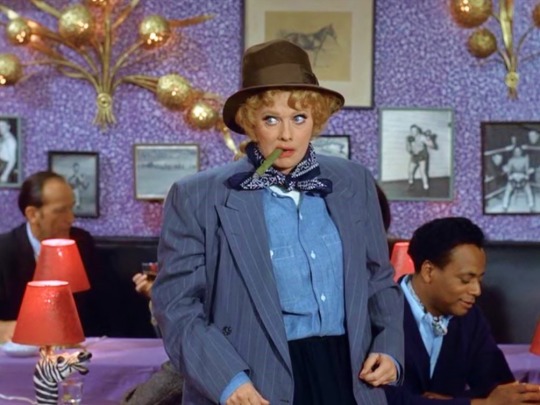
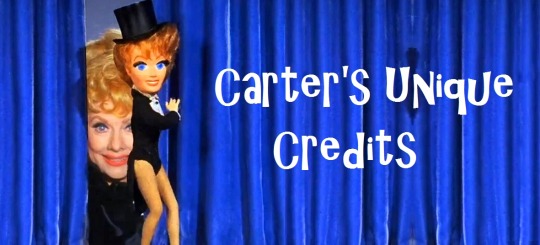
Directed
by Herbert Kenwith ~ Written by Larry Rhine and Lou Derman
Synopsis
When
a woman and two children mysteriously move in next door, Lucy
discovers that they’re a band of criminals led by Ma Parker.
Reporting it to the police, Lucy is recruited to impersonate Ma
Parker and help nab a dangerous mob leader.
Regular
Cast
Lucille
Ball (Lucy
Carter), Gale
Gordon (Harrison
Otis Carter), Lucie
Arnaz (Kim
Carter), Desi
Arnaz Jr. (Craig
Carter)
Guest
Cast
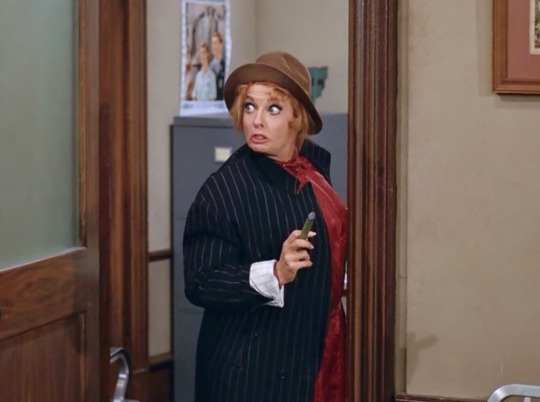
Carole
Cook
(Ma Parker) played
Thelma Green on “The Lucy Show” as well as a host of other
characters. She was a protege of Lucille Ball’s during the Desilu
Playhouse years. Although born as Mildred Cook, Ball suggested she
take the name Carole, in honor of Lucy’s great friend, Carole
Lombard. Cook appeared in five episodes of “Here’s Lucy.”
After
many years of playing supporting characters opposite Lucille Ball,
Carole Cook finally guest stars in a title role.
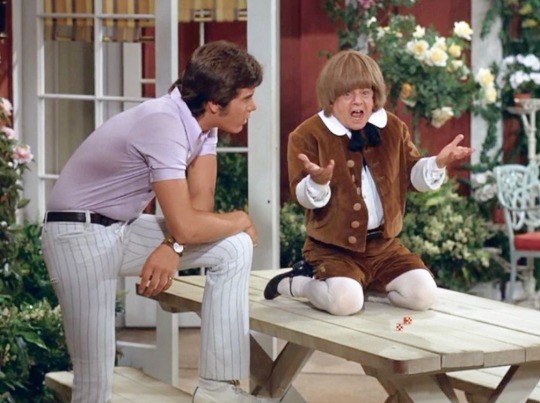
Billy
Curtis
(Herman Golab) was born Luigi Curto in 1909. He appeared as one of
the Munchkins in The
Wizard of Oz
(1939). Although Curtis was a singer, his munchkin singing voice was
dubbed by Pinto Colvig, who voiced all the dogs in 1964’s “Lucy is
Her Own Lawyer” (TLS S2;E23). He famously played McDonald’s Mayor
McCheese from its creation until his death. The character was retired
when Curtis died in 1988.
Curtis’s
first job was as a shoe salesman, so it is coincidental that his costume
resembles Buster Brown. Ironically, cast mate Jerry Maren
played Buster Brown on television and radio during the 1950s and
1960s.

Jerry
Maren (Milton
aka ‘Little Mildred’) played the Munchkin who hands Dorothy a welcome
lollipop in The
Wizard of Oz
(1939). Like Curtis, he also did commercials for McDonald’s, mostly
as the Hamburglar.
Mildred
is Carole Cook’s birth name. The character is costumed in the style
of Shirley Temple.
Harry
Hickox (Lieutenant
L. Hickox, below left) was
best known for playing anvil salesman Charlie Cowell in the 1962
film The
Music Man. He
played a drill sergeant in “Lucy
Gets Caught Up in the Draft” (TLS S5;E9).
This is the second of his three episodes of “Here’s Lucy,”
all as policemen.
The character was named after Lucy and Desi’s real-life business manager and Desilu vice-president Andrew Hickox. It was also given to a character played by Charles Lane in “The Business Manager” (ILL S4;E1).
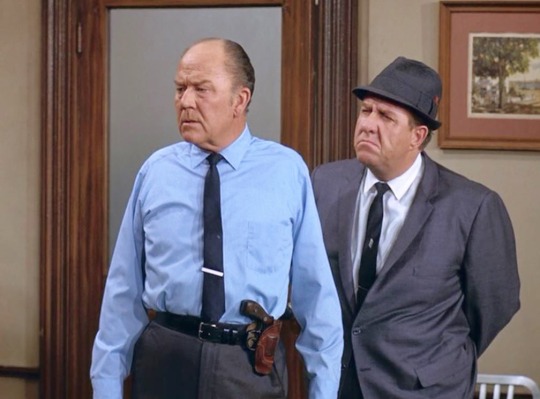
Stafford
Repp
(Police Detective Halloran, above right) made
a career of playing policemen even before he became famous as Chief
O’Hara on TV’s “Batman” (1966-68). He played two different
officers of the law on “Dennis the Menace” in 1962 and 1963,
alongside Gale Gordon. Repp made
two appearances on “The Lucy Show,”
but this is his only “Here’s Lucy” episode.
The
character is never addressed by name in the dialogue.
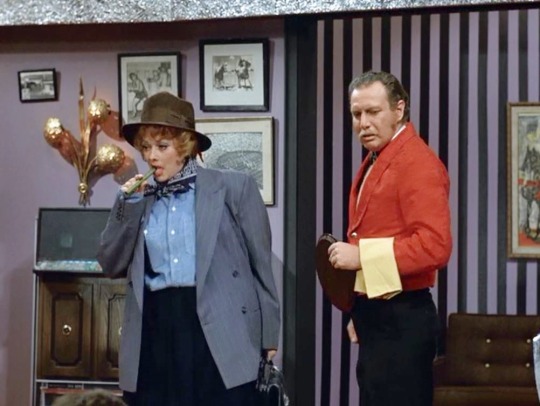
Emile
Autuori (Waiter
at the Red Devil) makes the first of his six appearances on “Here’s
Lucy.” He passed away in early 2017. He was the uncle of writer /
director P.J. Castalleneta.
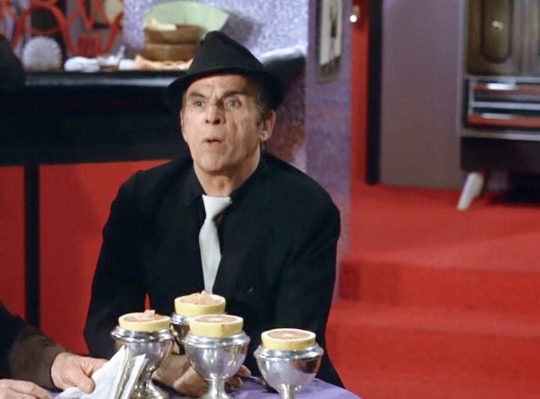
Marc
Lawrence
(Joe Grapefruit) appeared on Broadway in three plays with the Group
Theatre. On screen, Lawrence specialized in playing gangster roles.
He will also appear in “Lucy and Mannix Are Held Hostage”
(S4;E4). Coincidentally, Lawrence appeared in three episodes of
“Mannix,” which was a Desilu show.
Joe
Grapefruit is a mobster from Chicago.
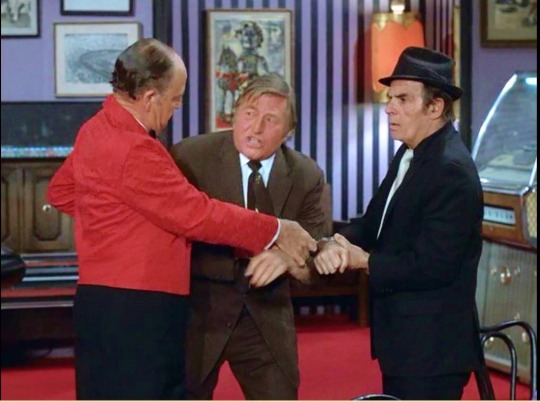
Boyd
‘Red’ Morgan
(Muggsy, above center) was
an actor and stunt man who was seen in “Lucy
and John Wayne” (TLS S5;E10),
with whom he did eleven films. This is the third of his four episodes
of “Here’s Lucy.”
Morgan
was cast because the character takes a hit to the face and falls off
a chair just as he did in “Lucy, the American Mother” (S3;E7).
Mickey
Martin
(Customer #1 at the Red Devil, uncredited, below center) appeared
with Lucille Ball in the 1934 film Kid
Millions starring
Eddie Cantor. He was also an uncredited extra in the 1947 Elizabeth
Taylor film Cynthia. This
is the last of his three episodes of “Here’s Lucy.”

Orwin
Harvey
(Customer #2 at the Red Devil, above left) was
an actor and stuntman who played one of the singing and dancing
teamsters in “Lucy
Helps Ken Berry” (TLS S6;E21).
This is one of his six appearances on “Here’s Lucy.”
Harvey
plays the burly man at the bar that Lucy lifts over her head. Both
Customer #1 and #2 do not have any dialogue but were cast for their
size.
Tony
Dante
(Customer of the Red Devil, uncredited) made more than 20 uncredited
appearances on Desilu’s “The Untouchables.” He also did two
episodes of “The Lucy Show.”
Walter
Smith
(Customer of the Red Devil, uncredited) made
13 mostly uncredited appearances on the series. He also did one
episode of “The
Lucy Show.”
Other
customers and staff of the Red Devil are played by uncredited
background performers.

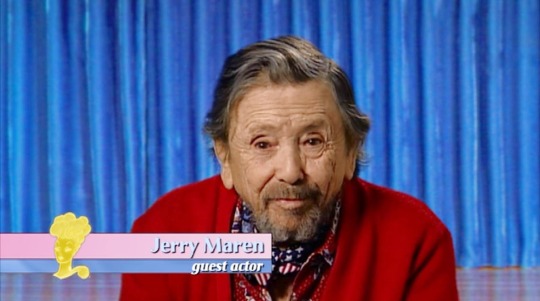
On
the series DVD, the episode is introduced by Carole Cook and Jerry
Maren, who says that the next day on the golf course he was ribbed
for playing ‘Little Mildred’!
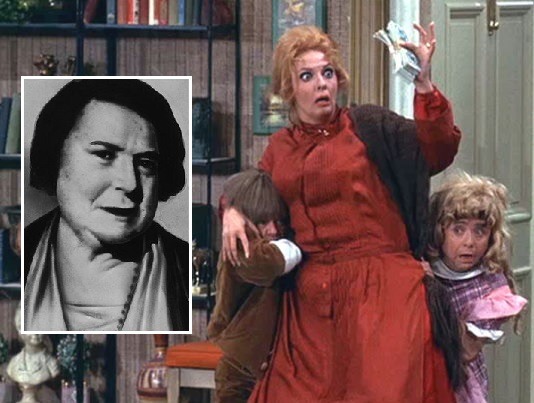
The
title character is a parody of Kate
‘Ma’ Barker (inset),
the
mother of several criminals who ran the Barker
gang
in the 1930s. She
traveled with her sons during their criminal careers.
She was previously mentioned in “Lucy and the Great Bank Robbery”
(TLS S3;E5).

In
2007, Jerry Maren (Milton) appeared at Jamestown’s annual Lucille
Ball Festival to discuss filming this episode. While being
interviewed,
he received
a surprise phone call from Desi Arnaz Jr.

Ma
Parker was also the name of one of TV’s “Batman” villains. She
was played by Shelley Winters (inset), who guest starred on a 1968
episode of “Here’s Lucy.” Winters is just one of many actors who
performed on both “Batman” and “Lucy”.
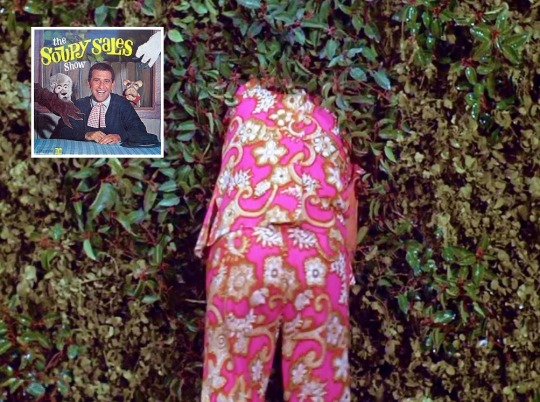
When
Lucy gets her head stuck in the hedge while spying on the neighbors,
Kim calls her mother “Snoopy Sales.” Milton Supman (aka Soupy
Sales, 1926-2009)
was best
known for his local and network children’s
television show, “Lunch
with Soupy Sales” (1953-66), a series of comedy sketches
frequently ending with Sales receiving a
pie in the face,
which became his trademark. From
1968 to 1975, he was a regular panelist on the syndicated revival of
“What’s
My Line?”

When
Lucy picks up the garden hose, a napping Harry is awakened by a
shower. The well-known “Here’s Lucy” formula: Harry + Garden Hose
= Wet!
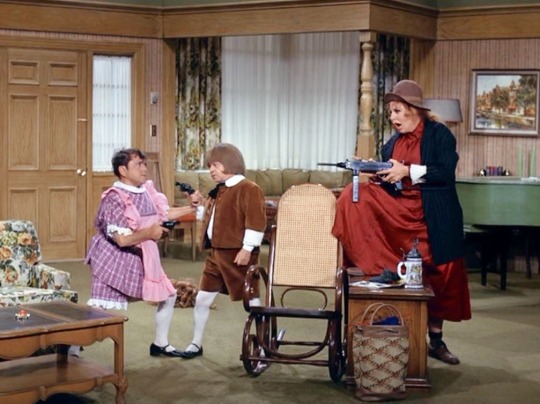
Typical
of Lucille Ball’s sitcom style (and the overall tone of this
episode), the ‘children’ are dressed in outfits that are vaudeville
stereotypes of children, not as children would be in 1970.

Lucy
gives the ‘children’ lollipops; appropriate since Jerry Maren played
one of the Lollipop Guild in The
Wizard of Oz (1939).
Additionally, Lucy carries a basket similar to Dorothy Gale’s.
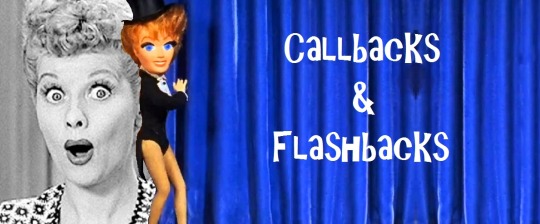

Lucy
Ricardo was suspicious of her “New Neighbors” (ILL S1;E21) who
were also suspected criminals (suspected by Lucy, that is). Lucy disguised herself as an armchair and hid in their closet to spy on them!
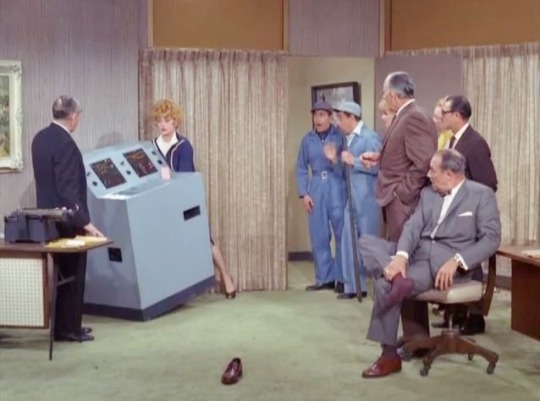
Lucy
Carmichael developed super-human strength in “Lucy, the Super
Woman” (TLS S4;E26).


Skill Set! Lucy
sits down at Ma Parker’s piano to sing the neighborhood welcome song,
but Lucy Carter has never been able to play the piano, just the
saxophone and the ukulele.
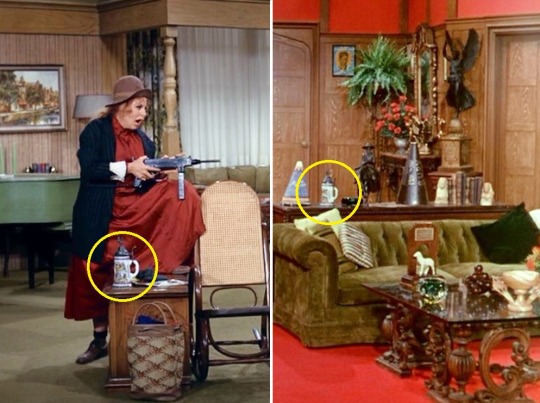
Props! The stein on Ma Parker’s end table is the same one seen in in Rudy
Vallee’s living room table in “Lucy and Rudy Vallee” (S3;E12).

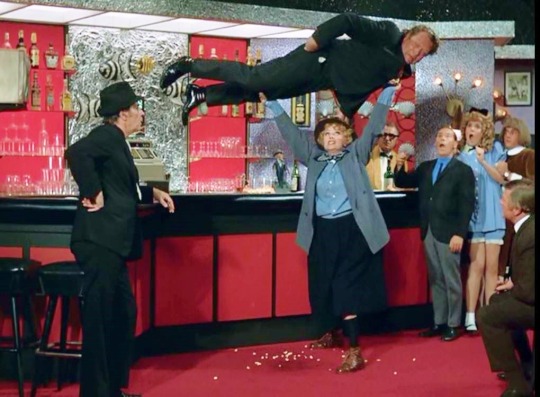
Foy Flaw! In
the medium shots of Customer #2 at the bar, the wires that will help
Lucy lift him in the air can be seen.

When
Lieutenant Hickox (disguised as waiter) handcuffs Joe Grapefruit, he
also must rip off his false beard with the other hand.
Unfortunately, half his mustache stays glued to his face. He quickly
does a second motion and rips it off, too!

“Lucy and Ma Parker” rates 1 Paper Heart out of 5
The
scene where Lucy visits Ma Parker as part of the neighborhood welcome
wagon feels like a satire or a sketch show – something Lucy and
company might act out in one of their musical episodes, but lacks any
sense of reality. Lucy behaves in a presentational manner as if
she’s putting on an act. I suppose that is what she felt necessary
to pull off the premise of not recognizing adult little people in
costumes. But when she mistakes actual machine gun fire for cork
bullets and lifts a big man over her head, well… so much for
Lucille Ball’s credo of sticking close to the truth. The final scene
is missing one key element – the ‘real’ Ma Parker! Additionally,
some of the comedy in this episode is derived from insulting remarks
and jokes about little people. In 1970 the term ‘midget’ was still
socially acceptable.
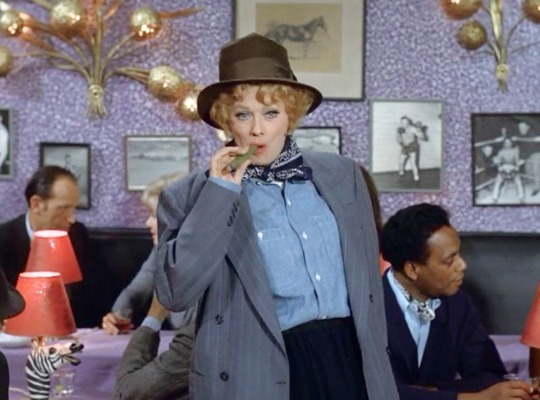
Leave a comment